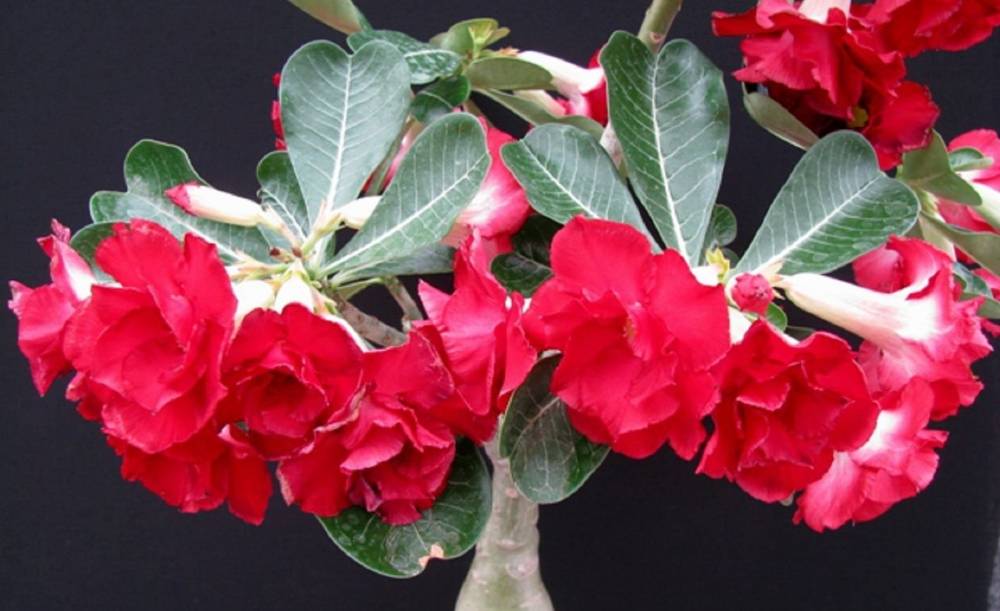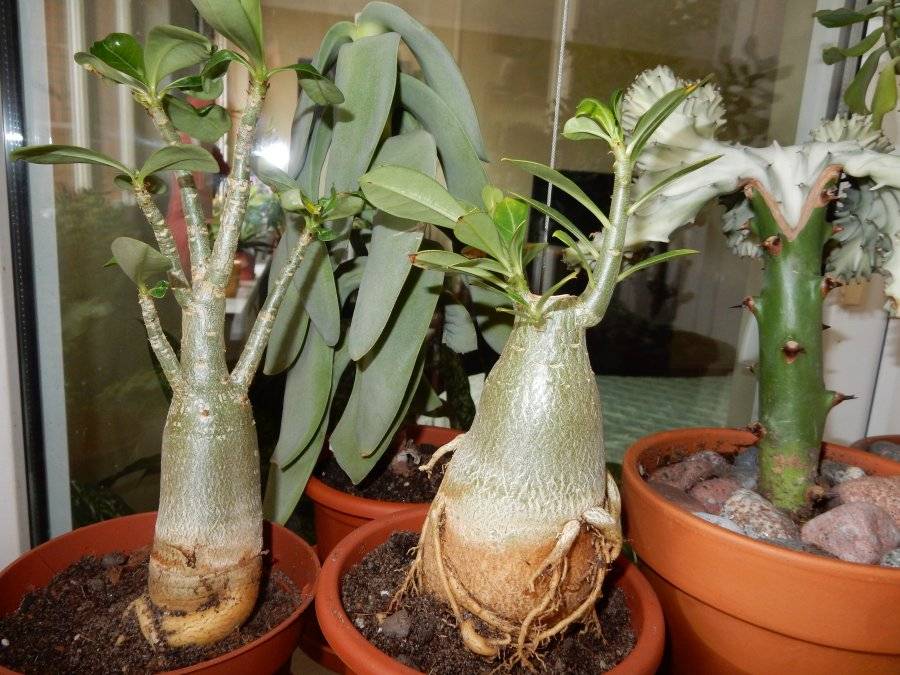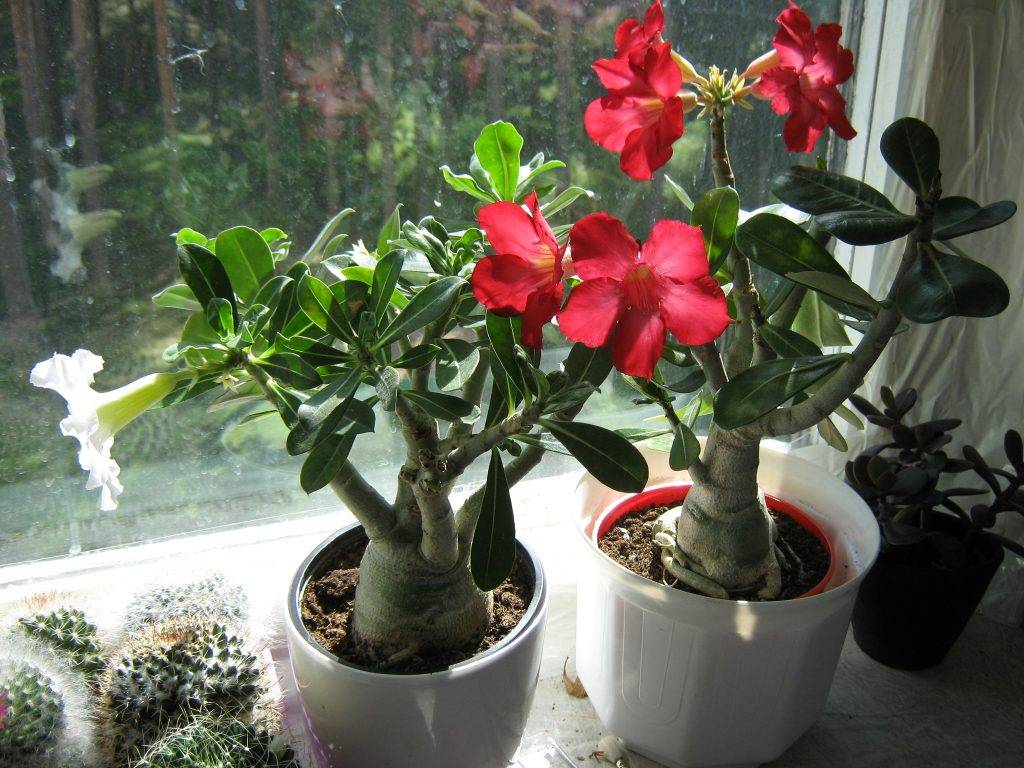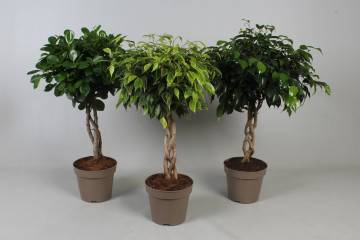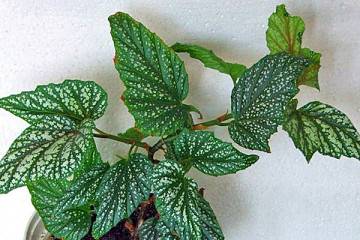Adenium obesum - description and care of the house
Content:
Adenium obesum, or fat adenium, is popularly called the desert rose. Indeed, the decorative flowering tree is very similar in appearance to rose bushes, it also blooms beautifully. Another characteristic feature is its unusual trunk, which thickens closer to the base at the roots.
What does adenium desert rose look like?
Adenium Obesum (Adenium Obesum) is a short flowering tree, reaching a height of no more than 1 m. The trunk is very massive and durable gray-brown shade. Closer to the base, the stem is thick, which is why the type of stem resembles the shape of a bottle. The plant can look like a tree or a bush.
The leaf plates, leathery to the touch, are colored gray-green. They have a spiral shape 10-15 cm long. The plant blooms with bright flowers that are soft to the touch.
Common varieties
More than 40 species of adenium grow in their natural environment. There are much fewer varieties bred by breeding.
A brief description of the appearance of the most common varieties grown at home:
- Adenium obesum (obesum) - a plant with white and pink flowers and a bottle-shaped stem;
- Adenium Arabicum has pink flowers and a wide caudex;
- Terry adenium is distinguished by small double buds that grow in two or three rows;
- Adenium Crispum, or Somali. A tall tree with small leaves. It blooms with pink and red flowers;
- Adenium Amber Cloud - a plant with two-colored buds: a cream-colored petal at the base, red-lilac at the edges;
- Adenium White Elephant - mini variety with double and triple petals of white-pink color;
- Adenium white has large white buds with a yellow base and variegated white-green foliage.
Adenium obesum and Arabicum have identical flowers, then what is the difference between them? In fact, only the buds of the bushes are similar, the very appearance of the trees is different. Arabicum grows rapidly and at the same time builds up a wide caudex, while as obesum slowly gains height and expands only at the base of the roots.
Healing properties
The appearance of the bush is very beautiful, but the plant itself, especially its juice, is poisonous. Its contact with the skin can provoke the appearance of a rash, itching, burns. Therefore, it is necessary to wear gloves during care activities and keep pets and children away from the flower.
Briefly about the history of appearance
Adenium in nature is most often found in the steppe and desert places. The birthplace of the tree is arid Africa and the Arabian Peninsula. The plant began to grow in ornamental conditions quite recently, but thanks to its unusual appearance, it quickly gained popularity.
Currently, the most famous plant nurseries are in Thailand, India and Taiwan.The best reputation among them belongs to the breeder "Adenium Rose Chen". In Russia, the tree can be purchased in online stores: "Mix Adenium" and "Adenimum-Sib", also known as "Adenium Siberia".
Features of caring for a plant at home
Home care for adenium obesum is simple. If the activities necessary for the healthy life of the bush are carried out on time and correctly, it will grow with lush foliage, it will bloom in time and will not get sick.
Temperature
The homeland of the plant is hot deserts, so it easily tolerates dry periods. But a low temperature will provoke a cessation of growth and flowering. The optimum temperature for growing is 25 ° C. During rest, the temperature must be lowered to 18 ° C.
Lighting
The plant needs abundant lighting. In the summer, the pot with a bush can be taken out into the fresh air. In winter, there is not enough light, so it is necessary to create artificial lighting. The more light, the better the adenium develops and blooms on time.
Watering
The watering regime is like that of cacti: thoroughly water the soil in a pot, and then dry it. The plant is not hygrophilous, but it cannot be allowed to dry out either.
Spraying
Spraying adenium must be done, especially in the summer. You need to spray the aboveground part of the bush and the soil in the pot. The procedure additionally nourishes the bush, as well as refreshes and removes accumulated dust on the leaf plates.
Humidity
Adenium needs high humidity for healthy growth. Humidity can drop in both summer and winter. To stabilize it, spraying with water from a spray bottle is carried out.
Priming
To grow adenium, a porous soil is needed, which, even in a wet state, is capable of having an air-permeable property. Therefore, a special soil mixture is prepared for planting, which consists of:
- loose chernozem soil;
- small drainage material, for example, expanded clay crumbs;
- humus or compost;
- perlite.
Top dressing
The first and last top dressing in the season should be applied in the form of a powdered fertilizer; in the intermediate summer period, the plant is fed with liquid preparations and nutrient solutions. Mineral fertilizers for adenium should contain increased levels of phosphorus, nitrogen and potassium.
Features of winter care
In winter, feeding is stopped, and watering is carried out once or twice a month, as the plant retires. During this period, it is imperative to prevent root rot, you need to periodically loosen the ground.
The temperature of the content must be lowered to 18 ° C and the pot must be removed to a more shaded place for the winter.
With the onset of cold weather, adenium gradually enters a state of rest. The winter period is fraught with the danger of caudex decay. It is advisable to place the plant in a cool place with a constant temperature of 10-16 ° C. If this threshold is exceeded, there is a high risk of triggering a wake-up call. When placing adenium for the winter, the temperature should be lowered gradually, sudden changes are unacceptable. Watering is necessary rarely, about once every 10 days, the moisture content of the soil is checked beforehand. Fertilizing the bush is not recommended.
When and how it blooms
Adenium desert rose blooms very beautifully, dissolving lush bright inflorescences.Flowering begins in early spring, but only in the third or fourth year after planting.
Types of flowers
The flowers of the plant, depending on the variety, can be of different shades and types. More common varieties with white and crimson petals. The petals can have a solid solid color, as well as two or three colors. Hybrid terry varieties can have a two-row arrangement of petals. The petals are smooth and double to the touch.
Flower shapes
The single-row flowers are star-shaped with pointed petals. Lush flowers are more spherical, the ends of their petals are wavy.
Flowering period
With proper care, the tree can bloom twice in one season. The first bloom occurs from April to July, and the second from September to October or November.
Changes in care during flowering
During the flowering period, the measures for the care of the adenium should not be changed. Only the regularity of watering increases and the soil is loosened more often. During flowering, it is necessary to monitor the illumination of the room where the bush is located. Shading of the tree must not be allowed.
Pruning
In the second year, the first pruning is done to thin out the dense crown and promote more abundant flowering. During the period of the most active growth in adult bushes, weak and thin stems are removed.
How adenium obesum multiplies
Adenium obesum is propagated by seeds and rooting of cuttings.
Germinating seeds
The germination of adenium seeds is high, so this method is one of the most widely used propagation methods. The seeds are treated with saline solutions that stimulate the active growth of the tree. The seeds are planted in a substrate and watered with a nutrient solution. The box must be placed in a well-lit, ventilated, but warm room. After emergence, the sprouts can be transplanted into a separate pot.
Rooting cuttings
The upper shoots are selected and cut to 10 cm. The cuttings are planted in a substrate and removed in a well-lit place. The stalk should take root after one month.
Transfer
Adenium transplant is carried out every spring in the first 3-4 years after planting, when the pot becomes cramped for the roots of the tree. Before planting in new soil, the roots are placed in water or nutrient solution for a couple of hours, then they are carefully straightened. Drainage material is covered at the bottom of the new container, then a layer of soil mixture, on which the bush is placed. Fall asleep with the remaining substrate and tamp. The first watering should not be abundant.
Possible growing problems and diseases
Problems can arise during the cultivation of adenium. To solve them and cure the plant, you need to find out why the plant behaves this way, what is the cause.
Drops buds and leaves
Buds and leaves begin to fall off due to lack of watering and feeding. If fertilizing is carried out regularly, but the plant still continues to lose foliage, it is possible that the dose and proportions of minerals are incorrect.
Leaves turn pale
The leaves begin to fade and fade with a lack of fertilizing, a decrease in temperature and a lack of lighting. If this happens in winter, then there is no danger to the health of adenium, because the plant is in hibernation and will begin active development with the arrival of spring.
The tips of the leaves dry
The edges of the leaf plates turn yellow due to sudden changes in temperature and drafts. In a similar way, the plant can also behave due to a lack of watering and a long exposure to direct sunlight.
The lower leaves fall
Excessive waterlogging of the soil leads to the subsidence of the lower sheets. If the bush is not treated, infectious diseases and mold can occur, and the stem will begin to turn black.
Pests
Of the pests, adenium is especially susceptible to the appearance of:
- spider mite;
- aphids;
- mealybug.
To destroy parasites, the plant is treated with special preparations - insecticides.
Signs and superstitions
According to feng shui, adenium obesui brings harmony and peace to the home. It is recommended to put a pot with a flower in rooms where all household members usually spend their free time.
The desert rose, although it arrived in Europe from arid deserts, grows well in mid-latitudes. Only following the rules and recommendations for caring for adenium will help to grow a healthy bush and achieve abundant and colorful flowering.

